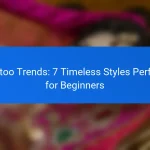Choosing the right tattoo artist is essential for achieving the design you envision. By evaluating their portfolio quality, ensuring a style match, and considering their experience, you can find an artist who meets your needs and upholds high standards of safety and artistry. A thoughtful selection process will lead to a more satisfying tattoo experience and a lasting piece of art on your skin.
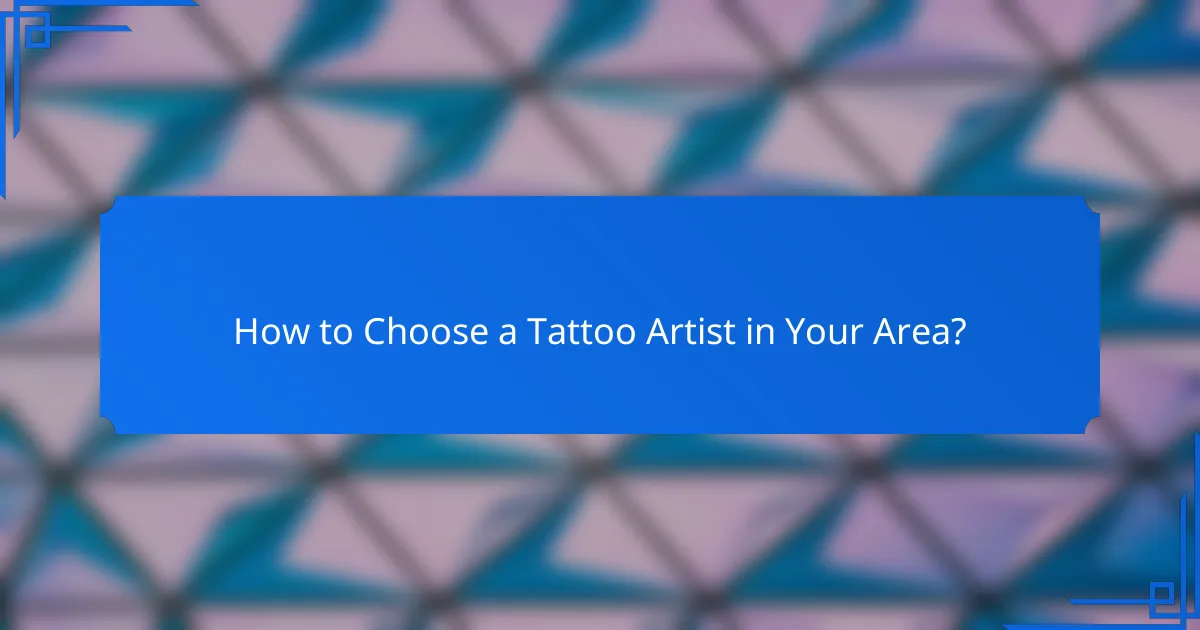
How to Choose a Tattoo Artist in Your Area?
Choosing a tattoo artist in your area involves evaluating their portfolio quality, ensuring their style matches your vision, and considering their experience. Focus on these aspects to find an artist who can create the tattoo you desire while maintaining high standards of safety and artistry.
Research local artists online
Start by searching for tattoo artists in your area through social media platforms and tattoo-specific websites. Look for portfolios that showcase a variety of styles, techniques, and completed works. Pay attention to customer reviews and ratings to gauge the artist’s reputation.
Many artists will have websites or Instagram profiles where you can see their latest work. Check for consistency in quality and whether their style aligns with your preferences. Look for artists who specialize in the type of tattoo you want, whether it’s traditional, realism, or abstract.
Visit tattoo studios in person
After narrowing down your options, visit the tattoo studios to get a feel for the environment. This allows you to assess cleanliness, professionalism, and the overall atmosphere. A reputable studio should have a welcoming vibe and adhere to health and safety regulations.
During your visit, take the opportunity to speak with the artists. Discuss your tattoo ideas and ask about their experience with similar designs. This interaction can help you determine if you feel comfortable with the artist and their approach to your vision.
Ask for recommendations from friends
Word-of-mouth recommendations can be invaluable when choosing a tattoo artist. Ask friends or family members who have tattoos about their experiences and the artists they used. Personal referrals often provide insight into the artist’s skill and professionalism.
If someone you trust has a tattoo you admire, inquire about their artist’s contact information. This can lead you to artists who have a proven track record of delivering quality work. Additionally, consider joining local tattoo forums or social media groups to gather more opinions and suggestions.

What Should You Look for in a Tattoo Artist’s Portfolio?
When evaluating a tattoo artist’s portfolio, focus on the quality of their work, the range of styles they offer, and their consistency in technique. A well-rounded portfolio will help you determine if the artist can meet your specific tattoo needs and preferences.
Quality of previous work
The quality of a tattoo artist’s previous work is paramount. Look for clear, crisp lines, vibrant colors, and well-executed shading. High-quality tattoos should show attention to detail and a polished finish, indicating the artist’s skill level.
Check for healed tattoos in the portfolio, as they reveal how the work ages over time. A good artist will have examples of tattoos that have maintained their integrity and appearance after healing.
Diversity of styles
A diverse portfolio showcases an artist’s versatility and ability to adapt to different tattoo styles. Whether you prefer traditional, realism, watercolor, or geometric designs, an artist who can demonstrate proficiency across various styles is more likely to meet your vision.
Consider asking the artist about their favorite styles and any specialties they may have. This can help you gauge whether their artistic inclinations align with your desired tattoo aesthetic.
Consistency in technique
Consistency in technique is crucial for ensuring that every tattoo you receive meets a high standard. Review the portfolio for uniformity in line work, shading, and color application across different pieces. This consistency indicates that the artist has mastered their craft.
Look for feedback from previous clients regarding their experiences. Positive reviews often highlight an artist’s reliability and the quality of their work over time, reinforcing their consistency in technique.
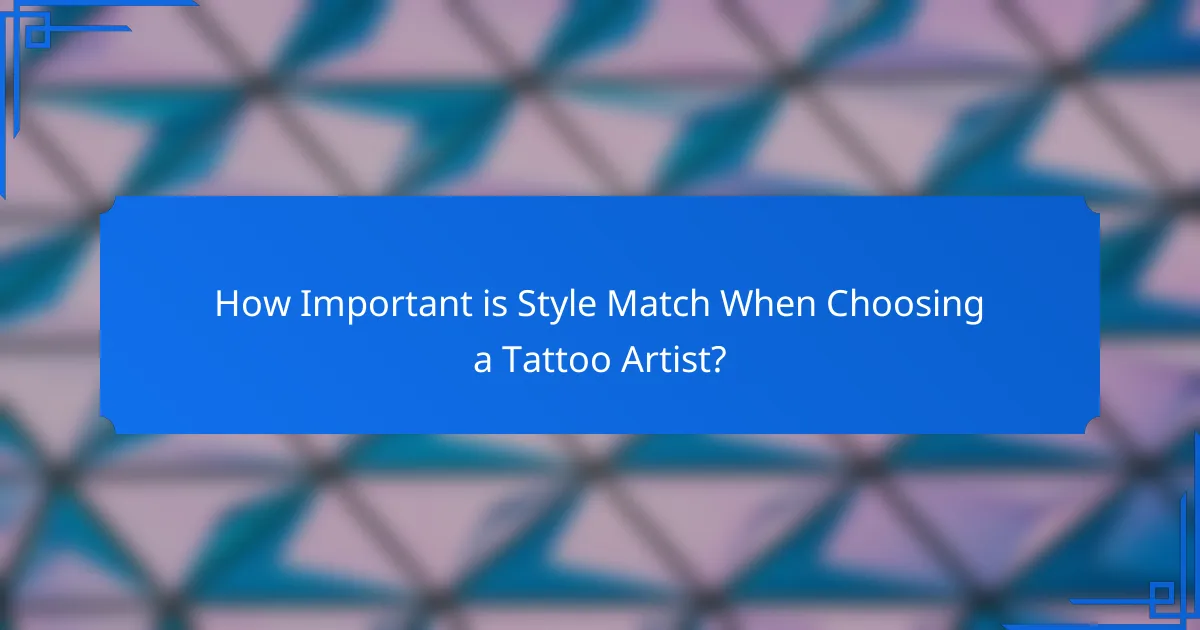
How Important is Style Match When Choosing a Tattoo Artist?
Style match is crucial when selecting a tattoo artist, as it ensures the artist’s work aligns with your personal vision. A good fit can lead to a more satisfying tattoo experience and a final product that you will cherish for years.
Aligning with personal aesthetic
Your personal aesthetic plays a significant role in choosing a tattoo artist. Look for artists whose portfolios reflect styles that resonate with your tastes, whether that be traditional, neo-traditional, realism, or abstract. This alignment will help ensure that the final tattoo feels authentic to you.
Consider creating a mood board or collecting images that represent your desired style. This can serve as a helpful reference when discussing your ideas with potential artists, making it easier to find someone who understands your vision.
Understanding specific tattoo styles
Each tattoo style has unique characteristics that can affect the outcome of your tattoo. For instance, traditional tattoos often feature bold lines and vibrant colors, while watercolor tattoos use softer hues and fluid designs. Familiarizing yourself with these styles can help you make an informed decision.
Research various tattoo styles and their typical elements to determine what appeals to you. Look for artists who specialize in the styles you like, as they will have the expertise to execute your vision effectively. Don’t hesitate to ask potential artists about their experience with specific styles during your consultations.
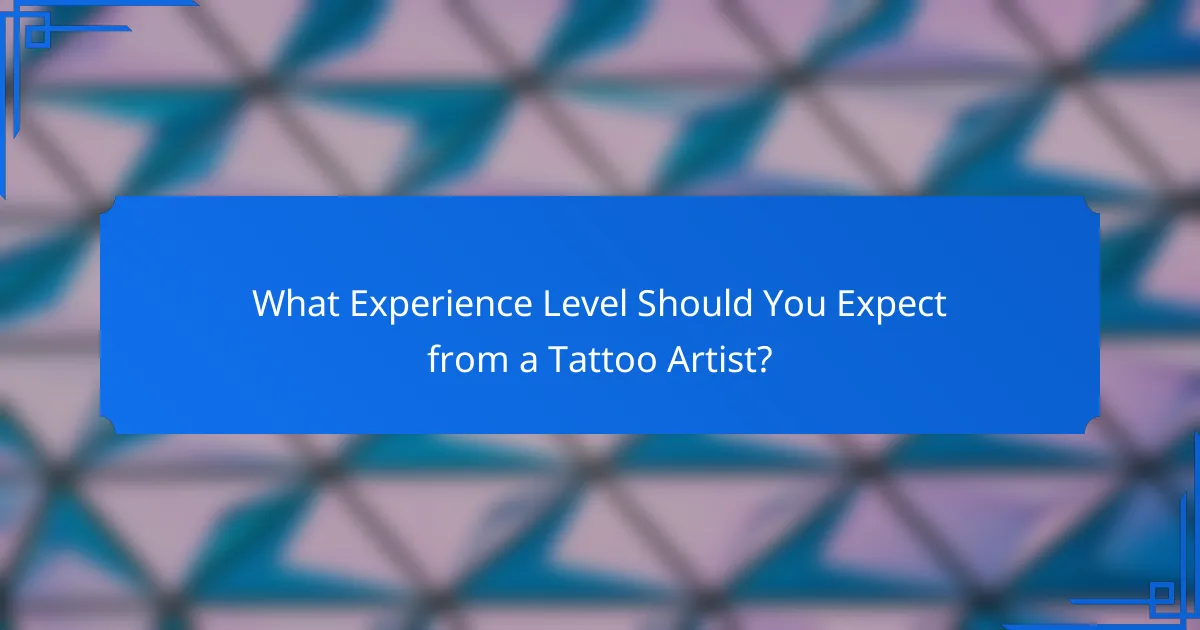
What Experience Level Should You Expect from a Tattoo Artist?
When choosing a tattoo artist, expect a range of experience levels that can significantly impact the quality of your tattoo. Generally, artists with several years of professional practice and specialization in specific techniques will provide a higher standard of work.
Years of professional practice
Years of professional practice can vary widely among tattoo artists, from a few years to over a decade. Typically, artists with 3 to 5 years of experience have developed a solid skill set and a portfolio showcasing their work. Those with more than 10 years often have a refined style and a deeper understanding of skin types and tattoo techniques.
When assessing an artist’s experience, consider their portfolio and client reviews. Look for consistency in quality and a variety of styles, which can indicate a well-rounded artist. Avoid artists with minimal experience if you are seeking intricate or large-scale tattoos.
Specialization in certain techniques
Many tattoo artists specialize in specific techniques, such as realism, traditional, or watercolor styles. This specialization can greatly influence the outcome of your tattoo, so it’s essential to choose an artist whose expertise aligns with your desired design. For example, if you want a detailed portrait, seek out artists known for their realism.
Before making a decision, review the artist’s portfolio to see examples of their specialized work. Don’t hesitate to ask questions about their techniques and experience with similar designs. This will help ensure that you find an artist who can deliver the tattoo you envision.
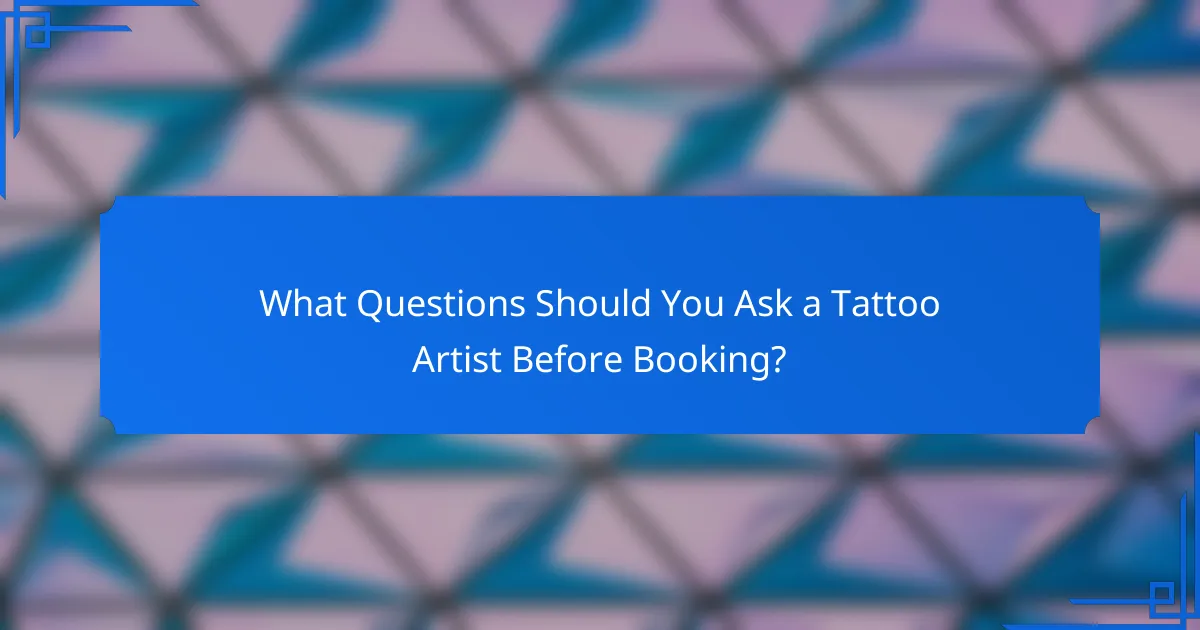
What Questions Should You Ask a Tattoo Artist Before Booking?
Before booking a tattoo artist, ask about their hygiene practices, design ideas, and experience. These questions help ensure you choose a professional who aligns with your vision and maintains high standards of safety.
Inquire about hygiene practices
Hygiene is crucial in tattooing to prevent infections and complications. Ask the artist about their sterilization methods, including whether they use single-use needles and equipment. A reputable artist should be able to explain their cleaning protocols clearly.
Additionally, check if the studio is licensed and follows local health regulations. In many places, tattoo parlors are required to adhere to strict hygiene standards, so ensure they display their licenses prominently.
Discuss design ideas and revisions
When discussing design ideas, be clear about your vision and preferences. A good tattoo artist will listen actively and provide feedback based on their expertise. This collaboration can help refine your concept into a tattoo that you will love.
Ask about the revision process as well. Some artists may include a certain number of adjustments in their service, while others may charge extra for changes. Understanding this upfront can help avoid misunderstandings later on.

How Do Pricing Structures Work for Tattoo Artists?
Pricing structures for tattoo artists can vary significantly based on several factors, including the artist’s experience, the complexity of the design, and the time required to complete the tattoo. Understanding these structures can help you budget effectively and choose the right artist for your needs.
Hourly rates vs. flat fees
Tattoo artists may charge either hourly rates or flat fees for their work. Hourly rates typically range from around $50 to $300 per hour, depending on the artist’s skill level and location. Flat fees are often used for specific designs or projects, providing a clear total cost upfront, which can be beneficial for budgeting.
When considering which pricing structure to choose, think about the complexity of your desired tattoo. For simple designs, a flat fee may be more economical, while intricate pieces that require more time might be better suited to an hourly rate.
Factors affecting tattoo pricing
Several factors influence tattoo pricing, including the artist’s experience, the size and detail of the tattoo, and the location of the studio. More experienced artists often charge higher rates due to their skill and reputation, while larger and more detailed tattoos will naturally cost more due to the time and effort involved.
Additionally, geographic location plays a significant role in pricing. For example, studios in major cities may have higher rates compared to those in smaller towns. It’s essential to research local pricing trends and consider the artist’s portfolio to ensure you’re getting value for your investment.

